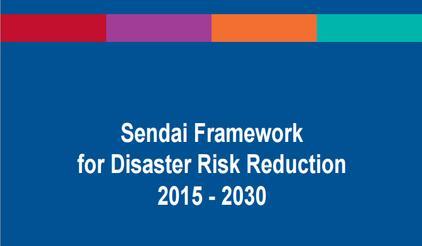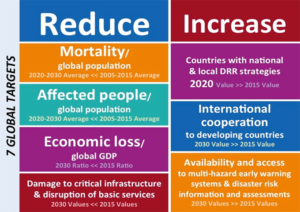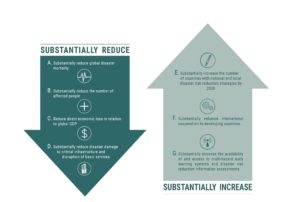
Table of Contents
What is Disaster Risk Reduction (DRR)?
- Disaster Risk Reduction (DRR) is the action taken with the objective of minimizing the risk that could be induced due to disaster.
- Disaster Risk Reduction is often taken as the synonymous for disaster risk management.
- The goal of Disaster Risk Reduction is to prevent new risks, reduce existing risks, and increase overall resilience.
- Disaster Risk Reduction (DRR) aims to reduce the damage caused by natural hazards like earthquakes, floods, droughts and cyclones.
Importance of Disaster Risk Reduction (DRR) strategies
- It helps to prevent the loss of lives and properties.
- It protects the lives and livelihoods of communities and individuals.
- Disaster could erase all the social and economic progress achieved till date. Thus, Disaster Risk Reduction strategies could prevent it.
Examples of Disaster Risk Reduction (DRR)
- Reducing exposure to hazards
- Construction of water management infrastructure like gabions, cages or cylinders made of wire and filled with rocks
- Lessening vulnerability of people and property
- Proper management of land and the environment etc.
Introduction to Sendai Framework
- The third United Nations conference on disaster risk reduction was held on Sendai, Japan from March 14 to 18 2015.
- At the time, 10-year-old Hyogo Framework came to an end and was replaced by Sendai Framework (2015-2030).
- Sendai Framework is the improved version of Hyogo Framework.
- The Sendai Framework is the successor instrument to the Hyogo Framework for Action (HFA) 2005-2015
- Sendai Framework is a 15- year non-binding agreement which recognizes that the state has the primary role to reduce disaster risk but the responsibility should be shared with other stakeholders and local government and private sector
- Sendai Framework is concise, forward-looking and action-oriented post 2015 framework for disaster risk reduction which consists of:
- 7 Global Targets
- 13 Guiding Principles
- 4 Priorities for Actions
Expected outcome
“The substantial reduction of disaster risk and losses in lives, livelihoods and health and in the economic, physical, social, cultural and environmental assets of persons, businesses, communities and countries”
Goal
“Prevent new and reduce existing disaster risk through the implementation of integrated and inclusive economic, structural, legal, social, health, cultural, educational, environmental, technological, political and institutional measures that prevent and reduce hazard exposure and vulnerability to disaster, increase preparedness for response and recovery, and thus strengthen resilience.”
Four (4) Priorities of Sendai Framework
- Priority 1: Understanding disaster risk
- Priority 2: Strengthening disaster risk governance to manage disaster risk
- Priority 3: Investing in disaster risk reduction for resilience
- Priority 4: Enhancing disaster preparedness for effective response and to “Build Back Better” in recovery, rehabilitation and reconstruction.
Seven (7) Global targets of the framework

2016 – Target (1): Substantially reduce global disaster mortality by 2030, aiming to lower the average per 100,000 global mortality rate in the decade 2020-2030 compared to the period 2005-2015;
2017 – Target (2): Substantially reduce the number of people affected globally by 2030, aiming to lower the average global figure per 100,000 in the decade 2020-2030 compared to the period 2005- 2015;
2018 – Target (3): Reduce direct disaster economic loss in relation to global gross domestic product (GDP) by 2030;
2019 – Target (4): Substantially reduce disaster damage to critical infrastructure and disruption of basic services, among them health and educational facilities, including through developing their resilience by 2030;
2020 – Target (5): Substantially increase the number of countries with national and local disaster risk reduction strategies by 2020;
2021 – Target (6): Substantially enhance international cooperation to developing countries through adequate and sustainable support to complement their national actions for implementation of the present Framework by 2030;
2022 – Target (7): Substantially increase the availability of and access to multi-hazard early warning systems and disaster risk information and assessments to people by 2030.

Strengths of Sendai Framework
- Sendai Framework focuses on increasing economic, social, health and environmental resilience which is a crucial for prevention strategy
- Sendai Framework uses post-disaster recovery and reconstruction to “Build Back Better” through support of strengthened modalities of international cooperation.
- It creates a working group to apply indicators and measure progress.
- Sendai Framework includes the need for the public, private sectors, civil society organizations, as well as academia and scientific and research institutions, to work more closely together and to integrate disaster risk into their management practices
- Sendai Framework is an agenda for international collaboration and reminds country of their responsibility.
- Sendai Framework provides a guide to the multi hazard management of disaster risk in development at all levels as well as within and across all sectors.
Limitations of Sendai Framework
- Sendai Framework tackles health, human rights and displacement (including forced migration) but with little details
- It has not mentioned about minorities in details
- Sendai Framework has weak links to climate change and sustainable development agendas.
- Sendai Framework has no clear commitment to financial aids for poorer countries to do disaster risk reduction.
- Sendai Framework includes targets but doesn’t precisely define one.
- Top-down approach for DRR doesn’t work.
- Details are vague and thus implementation can be difficult.
References and For More Information
https://www.preventionweb.net/files/43291_sendaiframeworkfordrren.pdf
https://www.eird.org/esp/acerca-eird/liderazgo/perfil/what-is-drr.html
https://www.riskmethods.net/resilient-enterprise/disaster-risk-reduction
https://www.preventionweb.net/files/54917_iddr2017conceptnote.pdf
https://reliefweb.int/sites/reliefweb.int/files/resources/49524_iddr2016conceptnotefinal.pdf
https://www.undrr.org/publication/sendai-framework-disaster-risk-reduction-2015-2030